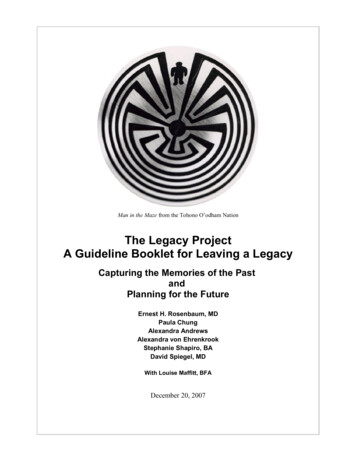
Transcription
The Rick Legacy: Planning, Designing andEngineering in San Diego Since 1927Brian F. MooneyAs a city and region, San Diego comprises a variety of unique, individualcommunities and neighborhoods. Located in a natural environment with astrong physical connection to Mexico, this blend of values and culture definesits identity as “Paradise.”1 Manycommunities and the region’smost iconic development projectshave been planned, designed,and engineered by the Rickfamily and the engineering andplanning firm they started in1955. These communities includeScripps Ranch, La Costa, RanchoBernardo, Rancho Peñasquitos,Loma Santa Fe, Liberty Station,Fairbanks Ranch, Carmel Valley Rick Engineering Company headquarters on Friars Road, San(then known as North City West), Diego. Editor’s collection.Warner Springs Ranch, BlackMountain Ranch and high-profile developments including Qualcomm Stadium,numerous buildings on San Diego State University (SDSU) and the University ofCalifornia San Diego (UCSD) campuses, the Chula Vista Bayfront, tribal lands,and downtown hotels.Brian F Mooney AICP, is the Managing Principal of the Rick Engineering Company, CommunityPlanning and Sustainable Development Division. Brian received a Master of Arts in History fromthe Universality of San Diego, with a special focus on city planning in the 20th century and aBachelor of Arts in Anthropology from San Diego State University.57
The Journal of San Diego HistoryGlenn Rick: Planning San DiegoGlenn Rick came to SanDiego from Cedar Rapids Iowa in1927. Trained as a civil engineerat the University of Iowa and hisfather’s home building business,he moved to San Diego to buildhouses. Shortly after arriving, helearned that the homes he wasscheduled to build could notbe financed due to the declinein the housing market duringthe late 1920s.2 Rick became theAssistant City Planning Engineerto Kenneth Gardner, the CityPlanning Engineer in the newlyformed City of San Diego’s CityPlanning Department. Gardner,an associate of John Nolen, whoprepared the first City of San DiegoComprehensive Plan in 1907, hadbeen retained to update the plan in1926. The San Diego City Council Glenn Rick looking at housing distribution in San Diego.approved the update in 1927 and SDHC UT #1A01398.the new City Planning Departmentworked to implement the plan including a new Zoning Ordinance that dividedthe City into residential zones R-1, R-2 and R-4, commercial zones C-1 and C-2,and manufacturing zones of M-1 and M-2. The process was controversial andtook several years to complete but eventually covered all neighborhoods.3Over time, Glenn Rick was promoted to City Planning Engineer and in 1928 wasnamed City Planning Director. He was responsible for the implementation of Nolen’s1927 vision throughout San Diego, including land use and transportation issues.In a local newspaper article published in 1936 and titled, “What Will San Diego BeLike in 1950? Planning Engineer Rick Sees Better Streets, More Civic Buildings, Parkand Harbor Programs,” Rick identified key issues for the city such as completingthe Harbor Development Plan, extending the park system into densely populatedneighborhoods, securing a sustainable water supply, developing a modern sanitationsystem, and solving the city’s traffic and parking problems.458
The Rick Engineering Company LegacyRick was known for promoting the planning growth of San Diego in aresponsible and comprehensive way. In 1939, he hosted a radio show titled “KnowYour San Diego.” During the radio hour, Rick emphasized that San Diegans hadalways made up an enterprising community by balancing beauty with lifestyleand industry. He announced that the Consolidated Aircraft Corporation, underthe direction of Major Reuben H. Fleet, would be creating additions to theirfactory along the Pacific Coast Highway that would be built with the intentionof improving the corridor, so the City Planning Commission could readilyapprove the development. Rick also spoke about the importance of beautifyingthe waterfront and the development of Harbor Drive:The plans for the development of this natural asset call for thecontinuation of Harbor Drive from Market Street around the Bayto Playa in Point Loma. The proper development of this 200-footwide waterfront drive will result in the most beautiful and practicalasset this city has. Balboa Park is indeed a wonderful exhibit, with1,400-acres filled with such things as a splendid zoo, golf courses, artgallery, and other cultural and recreational attractions. But what othercity in the United States has the opportunity of developing waterfrontdrive such as San Diego has?5World War II and The Rise of Mission BayEverything changed with the onset of World War II as the City and allplanning functions focused on the war effort. Lucinda Eddy summarized theimmediate impact of the war:Almost overnight San Diego was transformed from a sleepy bordertown to a teeming wartime metropolis. Life Magazine and other nationalpublications referred to San Diego as a “boom-town,” but the SaturdayEvening Post best described the tremendous changes taking place asthe “Blitz-Boom.” San Diego’s major defense industry, aircraft, metthe challenges of expanded production and began 24-hour, 7-day aweek operations. . . . San Diego claimed the Navy’s largest air baseand the city’s harbor housed the repair and operations base for manyof the Navy’s major aircraft carriers. U. S. Army and Marine Corpscamps sprang up throughout the county to train the large numbersof incoming soldiers. The influx of civilian and military personnelcaused the city’s population to soar. By summer, 1941, the populationhad increased from 203,000, to more than 300,000, surpassing in littlemore than a year the projected growth for the next two decades.659
The Journal of San Diego HistoryMission Bay development, Aerial, 1949. SDHC OP: 14266-15.Near the end of the war, the San Diego City Council feared that the GreatDepression would return and attempted to identify ways the city could bolster itsidentity as a tourist destination. After two successful expositions in Balboa Park(1915 and 1935), San Diego needed a new attraction and identified Mission Bay.Glenn Rick is probably best known as the “Father of Mission Bay.” Theproject was formally integrated into the city budget in 1944 and the San DiegoCity Council designated Rick to “supervise the work of converting Mission BayState Park into a top-notch municipal playground.”7 The program came undersignificant scrutiny in a news article in the New York Herald Tribune (October 5,1947) as well as in articles in Los Angeles and San Francisco claiming that SanDiego was turning a “mud-hole into Coney Island at the cost of 14,000,000.” Rickquickly challenged the inaccurate identification and degrading connection witha “recreation slum” like Coney Island with “lunch stands, beer gardens and hotdog stands.” Instead, the project called for the design of a natural looking bayoriented around swimming, sailing and water sports, complimented by exclusive,luxury hotels. Under his direction, Mission Bay came to fruition and remains asone of San Diego’s prized attractions.60
The Rick Engineering Company LegacyRick served as Planning Director until 1955 when he retired from the Cityand opened Glenn A. Rick and Sons (later renamed Rick Engineering Company)with his sons Wallace and William (Bill) Rick. While Glenn focused on planning,Bill led the civil engineering services and Wally managed the survey division.Rick Family TiesGlenn’s two sons carried on the family company. Wally Rick, born in 1928in San Diego, attended Point Loma High School and San Diego State University,before joining Glenn A. Rick and Sons. Through his professional dedication andhis efforts as head of the land surveying and mapping division, many of thestandards Wally set into place are still in practice today throughout the county.In 1972 Wally became President of the newly formed Mission Aerial also housedin the Rick offices to provide Aerial Mapping to the engineering firm and Billbecame President of the renamed Rick Engineering Company. Wally served asa Vice President of the Rick Engineering Company.The Career of William (Bill) RickBill played an integral role in the development of San Diego much like hisfather. Originally enrolled at the Naval Academy in Annapolis, Bill received aBachelor’s Degree in Civil Engineering from UCLA in 1949 and enlisted in theAir Force where he became a Second Lieutenant in the “Sanitary EngineeringDivision.” He went on to become active in both civil engineering and planningorganizations, and served on the Port of San Diego Board of Port Commissionersand Coastal Commission as an appointee of Mayor and later Governor PeteWilson.8 In 1987, the California Society of Professional Engineers named Bill“Engineer of the Year” for his contributions in developing San Diego.As president of Rick Engineering, Bill Rick became heavily involved in publicservice. He was appointed to the Board of Review for Land Development, Cityof San Diego; the Historical Sites Board; Park and Recreation Board; CaliforniaCoastal Commission; San Diego Energy Advisory Board; and the SenateAdvisory Committee on California/Mexico Business Relations. In the civicarena he was a director, trustee or officer for the American Cancer Society SanDiego Chapter, Bishops School, Sharp Hospital Foundation, LEAD San Diego,UCSD Cancer Foundation, KPBS Advisory Board, Mission Bay Association,Maritime Association of San Diego, San Diego Yacht Club, Cuyamaca Club,University Club, Fronteras de las Californias, San Diego Dialogue, UCSD Boardof Overseers, Hubbs-SeaWorld Research Institute and the Urban League. Bill61
The Journal of San Diego HistoryMayor Pete presenting awards to San Diegans with historical concern, (left to right) Reverend Robert Stevens,Bill Rick, and Lorraine Sundberg. March 10, 1972, SDHC #UT86:J9556.also wrote “Planning and Developing Waterfront Property” for the UrbanInstitute’s Technical Bulletin 49 in 1964.One of Bill’s greatest contributions during his time of public service was hiswork with the Port Commission to build the San Diego Bay Convention Center.By the late 1970s, the City of San Diego had embarked on a major redevelopmentof the downtown area. One key piece to that redevelopment would be a newconvention center. There was one in Mission Valley at the Town and CountryHotel and another at Civic Center Plaza downtown. It became clear that therewas a great opportunity for the City of San Diego to compete nationally for largeconventions if they had a large and dramatic convention center.After extensive debate and passage of a construction measure in 1983, a sitewas chosen along Harbor Drive and an architecture competition was establishedto choose the most unique and appropriate design. The firm of Canadian ArchitectArthur Erickson was chosen and developed a concept of a ship along the harbor.Upon construction, however, commencement of the unique design uncoveredmajor issues with water leaking into the sub-basement. Bill, who had beenappointed to the Port Commission in 1981 by Mayor Pete Wilson, became chairmanof the Port Convention Center Building committee. He identified a practicalsolution that put the project back on schedule to open in 1989. He commented62
The Rick Engineering Company Legacyfor an article in San Diego Magazine at the opening ceremonies; “I’ve had so manyoccasions in the last eight years where the world was going to come to an end onthis job, that this is no great shakes of a problem to me. Having lived throughthe day when we thought we’d lost the whole foundation, plus a few other firstorder calamities, I’m not too panicky.” 9Community DevelopmentsWhile Rick Engineering Company has a long history of collaborating onhigh-profile projects, they are perhaps best known for their legacy of planningSan Diego’s iconic community developments.Rancho PeñasquitosIn 1962, real estate developer and San Diego attorney Irvin Kahn acquiredthe 14,000-acre parcel known as Rancho Peñasquitos with the intent of buildinga 150,000-resident planned community. He retained Rick Engineering Companyto develop a Master Plan. The community plan included a golf course, open space(what has become Peñasquitos Canyon Regional Park), commercial centers andnumerous distinctive residential neighborhoods.Irvin Kahn looks at a map of Rancho los Peñasquitos, 1962. SDHC UT85: c2821.63
The Journal of San Diego HistoryScripps RanchIn 1968, Macco Corporation and its subsidiary, Leadership Homes, purchasedthe 1,180-acre Miramar Ranch from Margaret Scripps Hawkins. The Master Planwas approved by the City Council in 1970 and in 1975, the ranch was sold to theCorky McMillan Company. The newly developed Scripps Ranch communitypetitioned the City of San Diego to form the Scripps Miramar Ranch CommunityPlanning Group in 1977 and retained Rick Engineering Company to prepare acomprehensive Community Plan. The City Council officially adopted the Rick’sCommunity Plan in 1978, which included extensive preservation of canyons,numerous parks, schools, and the eucalyptus forest.La CostaIn the mid 1970s, Rick Engineering was retained to help plan the communityof La Costa in Carlsbad. Originally established in 1960, La Costa was one of thefirst resorts to provide a full-service spa in association with La Costa Inn andchampionship golf course and tennis facilities. The original resort was developedby real estate entrepreneur Allard Roen who was involved with the Desert Innin Las Vegas through Moe Dalitz.10 The firm’s role was to plan and develop aresidential and commercial component including more than 20,000 homes in avariety of neighborhoods.Julian Burke, Jack Poole and Allard Roen (left to right) signing La Costa deal, March 10, 1981, SDHC#UT91:R2799 #3A-4.64
The Rick Engineering Company LegacyFairbanks RanchIn 1977, Ray Watt began assembling portionsof the original Douglas Fairbanks Rancho locatedsouthwest of Rancho Santa Fe. Fairbanks andhis wife, Mary Pickford, were famous silentmovie stars in the early 1900s. Fairbanks is bestknown for his roles as Zorro and Robin Hoodwhile Pickford was identified as “America’ssweetheart.” Watt hired Rick EngineeringCompany, in association with Mooney LettieriA sign marking Zorro Ranch ownedand Associates, to complete the Master Plan, by Douglas Fairbanks, 1977. SDHCincluding residential homes and a commercial UT90: O9329.center in association with the country club. Peran agreement with the City of San Diego, the plan included equestrian facilitiesto hold events for the 1984 Olympics held in Los Angeles.Chula Vista BayfrontIn 1986, Rick Engineering Company began preliminary engineering for theChula Vista Bayfront, one of the last high-profile development opportunitiesto create a distinctive destination for the public on San Diego Bay. This 400acre federal preserve, commercial, residential and resort development requireddecades of master planning, along with Coastal Commission and neighboringjurisdictional coordination. Rick Engineering Company continues to providemultiple services including planning and engineering to the City of Chula Vista,the San Diego Unified Port District, and private developers of the bayfront.Liberty StationIn 1993, the U.S. Navy announced its intention to close the Naval TrainingCenter (NTC) under the 1990 Base Closure Act. NTC, originally built in 1921,served as the major training facility for the navy through World War II, theKorean War, and the Vietnam War. In 1997, the City of San Diego retained RickEngineering Company to prepare a Master Plan that would preserve the historicalintegrity of the property while establishing new residential, commercial, and openspace. A special focus of the Master Plan for what would become known as LibertyStation, included preservation of the parade grounds, historic buildings, andarchitectural guidelines that were integral to the property’s history. The resulting65
The Journal of San Diego HistoryLiberty Stationredevelopment yielded the creation of 350 dwelling units, 500,000 square feet ofoffice/research and development area, over 100,000 square feet of mixed-use area,two hotels with 1,000-room capacity, and a Metropolitan Wastewater Laboratory.Beyond communities that Glenn, Bill, and Wally Rick personally served, theRick family legacy also lives on through the next generation of their company.No longer run by a Rick family member, but still showing the family name onits door, Rick Engineering Company continues to expand throughout California,Arizona, and Colorado.NOTES1.Roger Showley, Perfecting Paradise, (San Diego: Heritage Media, 1999).2.Glenn A. Rick, San Diego 1927-1955 Recollections of a City Planner, (San Diego, 1977): 41.3.Ibid., 48.4.Ibid., 116.5.Glenn A. Rick, Know Your San Diego, KGB, San Diego, 1939, Radio transcription.6.Lucinda Eddy, “War Comes to San Diego,” The Journal of San Diego History, (Spring 1993,Volume 39): 51-119.7. William Rick, “Mission Bay: An Engineer’s Vision Come True,” The Journal of San Diego History,(Winter 2002, Volume 48): 26-37.8. “A Collection of Life Member Memoirs,” American Society of Civil Engineers (2015): 23-25.9.10.66Bill Owens, “The Unconventional Center,” San Diego Magazine, (1990): 216.Don Bauder, “La Costa Developer Merv Adelson Dead at 85,” San Diego Reader, Sept. 10, 2015.
Planning and Sustainable Development Division. Brian received a Master of Arts in History from the Universality of San Diego, with a special focus on city planning in the 20th century and a Bachelor of Arts in Anthropology from San Diego State University. Rick Engineering Company headquarters on Friars Road, San Diego. Editor's collection.










